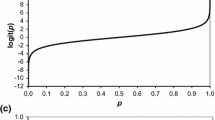Abstract
The box and whiskers plot (boxplot) has shown to be an effective data visualization tool in proficiency testing. The boxplot provides a quick visual summary of the considered data set . All the descriptive aspects of data reported in a round of a proficiency test can be studied with this plot. Location (through median and quartiles), spread (by means of the interquartile range), shape (position of the median in the box), and possible outliers (values beyond of the fences) are simultaneously observed with the boxplot. In this paper, we propose a modification of the inner fences of the boxplot, in such a way that they are in accordance with the approach based on the z score (standard ISO 13528) and therefore useful to recognize graphically questionable and unacceptable values in proficiency testing.









Similar content being viewed by others
References
Morales C, Giraldo R (2020) Reference versus consensus values in proficiency testing of clinical chemistry: a statistical comparison based on laboratories results in Colombia. Accred Qual Assur 25(2):99–105
ISO/IEC 17043 Conformity assessment-general requirements for proficiency testing (2010) International Organization for Standardization, Geneva, Switzerland
ISO 13528 Statistical methods for use in proficiency testing by interlaboratory comparison (2015) International Organization for Standardization, Geneva, Switzerland
Thompson M, Ellison S, Wood R (2006) The international harmonized protocol for the proficiency testing of analytical chemistry laboratories (IUPAC technical report). Pure Appl Chem 78(1):145–196
Zhao Y, Guo D, Huang Z, Chang W, Qi X, Li Z (2016) Proficiency testing for determination of formaldehyde in leather in china. TrAC Trends Anal Chem 82:279–285
Thompson M (2017) On the role of the mode as a location parameter for the results of proficiency tests in chemical measurement. Anal Methods 9(37):5534–5540
Li Tingting, Zhao Haijian, Zhang Cuanbao, Wang Wei, He Falin, Zhong Kun, Yuan Shuai, Wang Zhiguo (2019) Reasons for proficiency testing failures in routine chemistry analysis in china. Lab Med 50(1):103–110
Scott E, Cook G, Naysmith P (2010) The fifth international radiocarbon intercomparison (VIRI): an assessment of laboratory performance in stage 3. Radiocarbon 52(3):859–865
DiFrancesco R, Rosenkranz S, Taylor C, Pande P, Siminski S, Jenny R, Morse G (2013) Clinical pharmacology quality assurance (CPQA) program: models for longitudinal analysis of antiretroviral (ARV) proficiency testing for international laboratories. Ther Drug Monit 35(5):631
Chakravarty S, Mohanty A, Ghosh B, Tarafdar M, Aggarwal SG, Gupta P (2014) Proficiency testing in chemical analysis of iron ore: comparison of statistical methods for outlier rejection. Mapan 29(2):87–95
Mancin M, Toson M, Grimaldi M, Barco L, Trevisan R, Carnieletto P, Ricci A (2015) Application of bootstrap method to evaluate bimodal data: an example of food microbiology proficiency test for sulfite-reducing anaerobes. Accred Qual Assur 20(4):255–266
Walker M, Dovoedo Y, Chakraborti S, Hilton C (2018) An improved boxplot for univariate data. Am Stat 72(4):348–353
Babura B, Adam M, Fitrianto A, Rahim A (2017) Modified boxplot for extreme data. In: AIP conference proceedings, vol 1842. AIP Publishing LLC, p 030034
Barnett O, Cohen A (2000) The histogram and boxplot for the display of lifetime data. J Comput Graph Stat 9(4):759–778
Hibbert D, Gooding J (2006) Data analysis for chemistry: an introductory guide for students and laboratory scientists. Oxford University Press, Oxford
Ellison S, Barwick V, Farrant T (2009) Practical statistics for the analytical scientist. A bench guide. Royal Society of Chemistry
Iglewicz B, Hoaglin D (1987) Use of boxplots for process evaluation. J Qual Technol 19(4):180–190
R Core Team (2018) R: a language and environment for statistical computing. R Foundation for Statistical Computing, Vienna
Merker J, Devereaux K, Iafrate A, Kamel-Reid A, Kim S, Moncur J, Montgomery S, Nagarajan R, Portier B, Routbort M (2019) Proficiency testing of standardized samples shows very high interlaboratory agreement for clinical next-generation sequencing-based oncology assays. Arch Pathol Lab Med 143(4):463–471
Rousseeuw P, Ruts I, Tukey J (1999) The bagplot: a bivariate boxplot. Am Stat 53(4):382–387
Author information
Authors and Affiliations
Corresponding author
Additional information
Publisher's Note
Springer Nature remains neutral with regard to jurisdictional claims in published maps and institutional affiliations.
Rights and permissions
About this article
Cite this article
Morales, C., Giraldo, R. & Torres, M. Boxplot fences in proficiency testing. Accred Qual Assur 26, 193–200 (2021). https://doi.org/10.1007/s00769-021-01474-8
Received:
Accepted:
Published:
Issue Date:
DOI: https://doi.org/10.1007/s00769-021-01474-8




